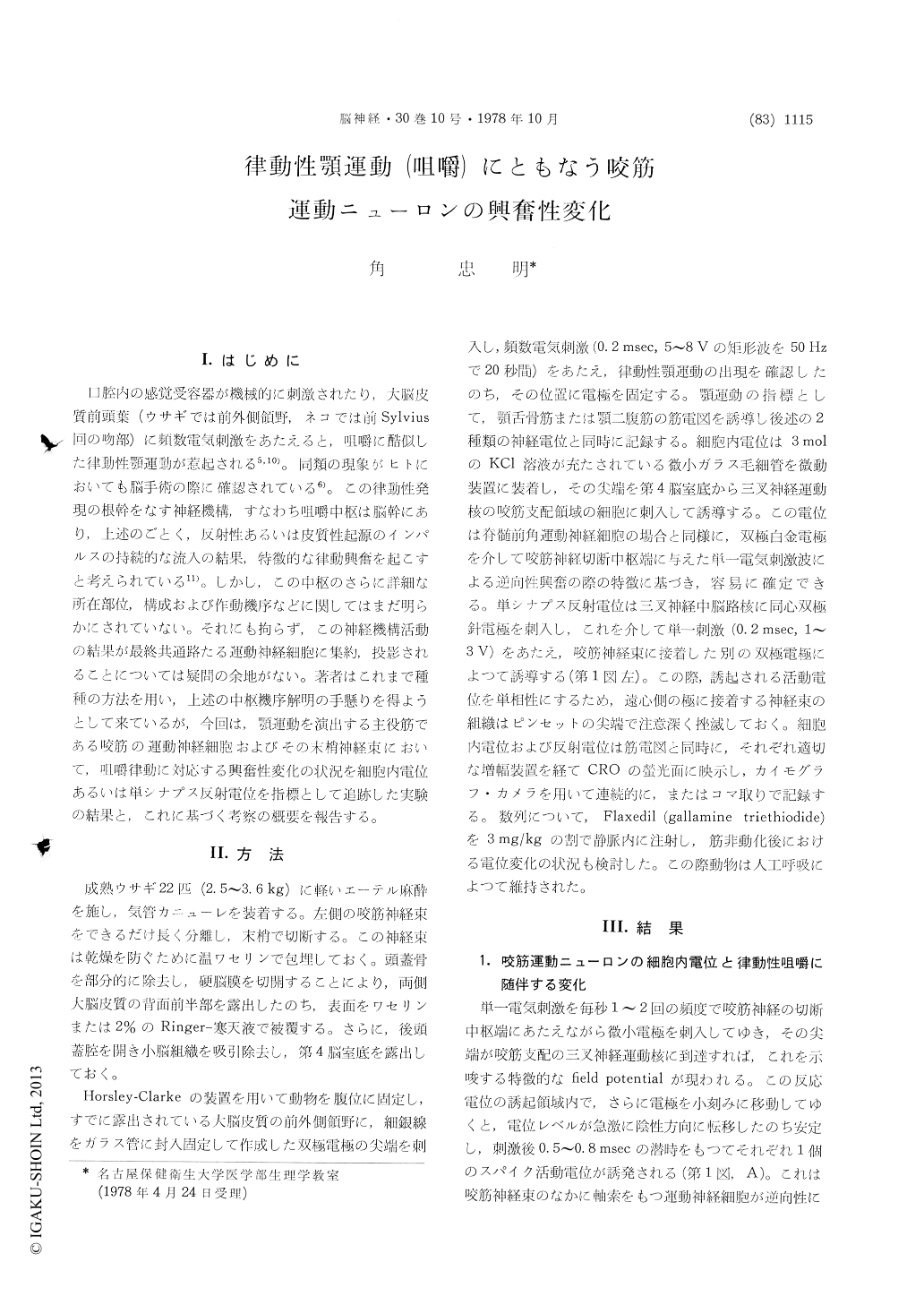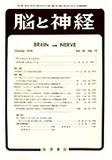Japanese
English
- 有料閲覧
- Abstract 文献概要
- 1ページ目 Look Inside
I.はじめに
口腔内の感覚受容器が機械的に刺激されたり,大脳皮質前頭葉(ウサギでは前外側頷野,ネコでは前Sylvius回の吻部)に頻数電気刺激をあたえると,咀嚼に酷似した律助性顎運動が惹起される5,10)。同類の現象がヒトにおいても脳手術の際に確認されている6)。この律動性発現の根幹をなず神経機構,すなわち咀嚼中枢は脳幹にあり,上述のごとく,反射性あるいは皮質性起源のインパルスの持続的な流入の結果,特徴的な律動興奮を起こすと考えられている11)。しかし,この中枢のさらに詳細な所在部位,構成および作動機序などに関してはまだ明らかにされていない。それにも拘らず,この神経機構活動の結果が最終共通路たる運動神経細胞に集約,投影されることについては疑問の余地がない。著者はこれまで種種の方法を用い,上述の中枢機序解明の手懸りを得ようとして来ているが,今回は,顎運動を演出する主役筋である咬筋の運動神経細胞およびその末梢神経束において,咀嚼律動に対応する興奮性変化の状況を細胞内電位あるいは単シナプス反射電位を指標として追跡した実験の結果と,これに基づく考察の概要を報告する。
In lightly anesthetized adult rabbits, when the anterolateral areas of the frontal cerebral cortexwere stimulated with repetitive electrical pulses, a sequence of rhythmic jaw movements (mastication) occurred. During the movements, intracellular potentials of the masseteric motoneuron showed a dome-shaped slow potential of depolarization super-posed with a burst discharge of multiple spike action potentials at each phase of jaw-closing.
The spike potentials occurred only when the depolarization crossed beyond a certain level of the intracellular potential, the threshold potential; the discharge pattern of the spike potentials depended on the grade, smoothness and duration of the slow potential depolarized beyond the threshold. When the jaw began to open, the depolarized potential turned to shift toward repolarization, ceased dis-charging the spike action potentials, and was followed by a keel-shaped slow potential of hyper-polarization that attained finally to the initial level of the intracellular potential, therefrom the next sequence of depolarization reappeared. Such rhythmic changes of intracellular potential ac-companied with mastication were preserved after motoparalysis brought about by the application of Flaxedil (gallamine triethiodide, 3 mg/kg, i. v.). Reflex contraction of the masseter ensued after the excitation of the proprioceptors there in : The monosynaptic reflex potential subserving this jaw-closing reflex enhanced in phase with jaw-closing and subsided with jaw-opening. The enhancement and subsidence of the reflex potential locking respectively to jaw-closing and jaw-opening of rhythmic mastication became prominent after motoparalysis of the animal. From these facts, it can be considered that the rhythmic and reciprocal succession of depolarization and hyperpolarization of the intracellular potential is taken place in the masseteric motoneurons, and the monosynaptic reflex excitability of the masseteric motor nucleus changes in phase with such changes in the intracellular potential of each constituent motoneuron. Further-more, the activation of various sensory receptors ensuing secondarily by the movement of the jaw may exert such reflex action that makes the jaw movement smoother; the modificating action may be achieved by minimizing both the enhance-ment and the subsidence of the excitability of the masseteric motoneuron occurring in phase with closing and opening of the jaw during rhythmic mastication. The behaviors of the intracellular potential of the masseteric motoneurons have been compared with those of the respiratory motoneurons in the spinal cord and of the respiratory neurons in the brain stem reticular formation, and discussed in the relevance to the rhythmic character of mastication and respiration.

Copyright © 1978, Igaku-Shoin Ltd. All rights reserved.


